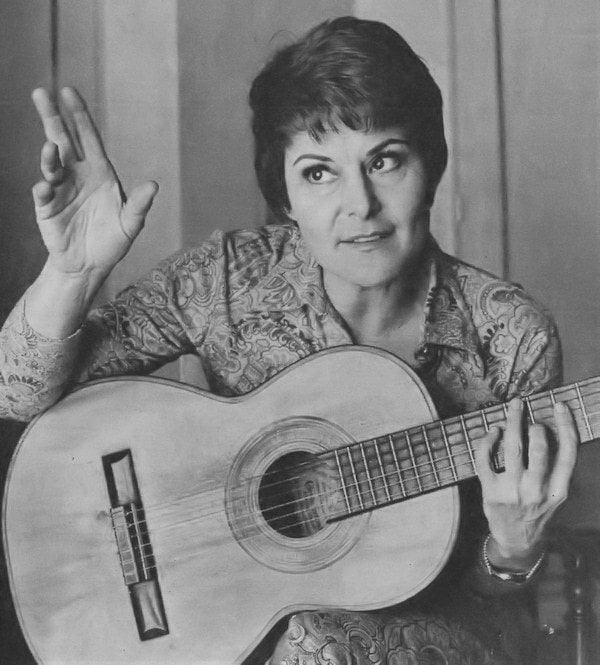Biography
Table of Contents
Introduction
Born into a humble family of Spanish immigrants in Gerli, Buenos Aires Province, on February 24, 1931, Eladia Blázquez emerged as a prominent figure in Argentine tango. In 1970, she made her mark by recording her first tango record, challenging the prevailing macho spirit that dominated the tango scene. Not confined to just singing, Eladia was a multifaceted artist—she excelled as a singer, composer, lyricist, pianist, and guitarist.
Eladia Blázquez and her contributions to Tango
Blázquez transmitted the essence of her Spanish heritage into her compositions. Despite facing criticism from tango “purists”, she was an innovator, weaving Spanish traditional music, South American melodic tunes, folkloric melodies, and heart-wrenching tango and soul-stirring ballads.
She authored two books, “Mi Ciudad y mi gente” and “Buenos Aires Cotidiana,” along with various works for Argentine folkloric musicians like Ramona Galarza and Los Fronterizos. Recognizing her significant contributions, she was named “Hija dilecta de la Ciudad de Avellaneda” in 1988 and “Illustrious Citizen of Buenos Aires” in 1992.
Blázquez’s repertoire boasts a diverse range of compositions, including the unforgettable “El corazón al sur,” “Sueño de barrilete,” “Mi ciudad y mi gente,” “Honrar la vida,” “Que vengan los bomberos,” “Bien nosotros,” “A un semejante,” “Viejo Tortoni,” “Con las alas del alma,” “Si Buenos Aires no fuera así,” “Somos como somos,” “Sin piel,” “Prohibido prohibir,” “Si somos gente,” and “Convencernos.”
Maybe her most well-known composition is “El corazón al sur”, a beautiful heart-touching ballad with a lot of Tango allusions, without falling into any clichés or committing fully to a single genre.
Recognizing her brilliance, Blázquez received the prestigious Premio Konex Award in 1995 and 2005, recognizing her as the best lyricist and composer of tango in Argentina for the preceding decades. Unfortunately, the tango world lost a luminary on August 31, 2005, when Eladia Blázquez succumbed to cancer at the age of 74 in the Clínica Bazterrica in Buenos Aires.
Discography
Top 10 Most Important Songs by Eladia Blázquez
- “El corazón al sur”
- Recording Year: Not specified
- Details: This iconic ballad with tango roots, resonates for its emotional depth and captivating melody.
- “Sueño de barrilete”
- Details: A testament to Blázquez’s diverse styles, this composition blends South American melodic elements seamlessly, creating a timeless piece admired by tango enthusiasts.
- “Mi ciudad y mi gente”
- Details: Blázquez’s reflections on her city and people come to life in this composition, offering a glimpse into the soul of Buenos Aires through her eyes.
- “Honrar la vida”
- Details: Known for its profound lyrics, this ballad is a tribute to life itself, capturing the essence of Blázquez’s poetic prowess and musical finesse.
- “Que vengan los bomberos”
- Details: This upbeat and lively tango, urging the firefighters to come, remains a favorite in milonga dance events for its energetic rhythm and playful spirit.
- “Con las alas del alma”
- Details: A composition rich in emotional nuances, “Con las alas del alma” showcases Blázquez’s ability to evoke profound feelings through her music.
- “Viejo Tortoni”
- Details: As an ode to the historic Café Tortoni, this tango captures the nostalgia and history of Buenos Aires, making it a staple in tango repertoires.
- “Si Buenos Aires no fuera así”
- Details: Reflecting on the city’s character, this tango explores the intricate relationship between the artist and Buenos Aires, creating a poignant musical narrative.
- “Somos como somos”
- Details: This composition embraces the complexities of human nature, resonating with dancers for its lyrical depth and rhythmic appeal.
- “Prohibido prohibir”
- Details: Blázquez’s rebellious spirit shines through in this composition, challenging norms and restrictions, making it a timeless anthem for those who embrace the unconventional in tango.
Frequently Asked Questions about Eladia Blázquez
When did Eladia record her first tango record?
Eladia recorded her first tango record in 1970.
What awards did Blázquez receive during her career?
Eladia received the Premio Konex Award in 1995 and 2005, recognizing her as the best lyricist and composer of tango in Argentina for the preceding decades.
What were Eladia’s notable contributions beyond tango?
Blázquez authored two books, “Mi ciudad y mi gente” and “Buenos Aires cotidiana,” along with various works for Argentine folkloric musicians Ramona Galarza and Los Fronterizos.






